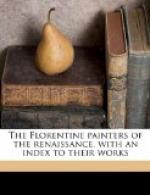instant of his fall he had been suddenly congealed
and suspended in space. A figure like this may
have a mathematical but certainly has no psychological
significance. Uccello, it is true, has studied
every detail of this phenomenon and noted down his
observations, but because his notes happen to be in
form and colour, they do not therefore constitute
a work of art. Wherein does his achievement differ
in quality from a coloured map of a country?
We can easily conceive of a relief map of Cadore or
Giverny on so large a scale, and so elaborately coloured,
that it will be an exact reproduction of the physical
aspects of those regions, but never for a moment should
we place it beside a landscape by Titian or Monet,
and think of it as a work of art. Yet its relation
to the Titian or Monet painting is exactly that of
Uccello’s achievement to Giotto’s.
What the scientist who paints—the naturalist,
that is to say,—attempts to do is not to
give us what art alone can give us, the life-enhancing
qualities of objects, but a reproduction of them as
they are. If he succeeded, he would give us the
exact visual impression of the objects themselves,
but art, as we have already agreed, must give us not
the mere reproductions of things but a quickened sense
of capacity for realising them. Artistically,
then, the naturalists, Uccello and his numerous successors,
accomplished nothing. Yet their efforts to reproduce
objects as they are, their studies in anatomy and perspective,
made it inevitable that when another great genius did
arise, he should be a Leonardo or a Michelangelo,
and not a Giotto.
[Page heading: ANDREA DEL CASTAGNO]
Uccello, as I have said, was the first representative
of two strong tendencies in Florentine painting—of
art for dexterity’s sake, and art for scientific
purposes. Andrea del Castagno, while also unable
to resist the fascination of mere science and dexterity,
had too much artistic genius to succumb to either.
He was endowed with great sense for the significant,
although, it is true, not enough to save him completely
from the pitfalls which beset all Florentines, and
even less from one more peculiar to himself—the
tendency to communicate at any cost a feeling of power.
To make us feel power as Masaccio and Michelangelo
do at their best is indeed an achievement, but it requires
the highest genius and the profoundest sense for the
significant. The moment this sense is at all
lacking, the artist will not succeed in conveying
power, but such obvious manifestations of it as mere
strength, or, worse still, the insolence not infrequently
accompanying high spirits. Now Castagno, who
succeeds well enough in one or two such single figures
as his Cumaean Sibyl or his Farinata degli Uberti,
which have great, if not the greatest, power, dignity,
and even beauty, elsewhere condescends to mere swagger,—as
in his Pipo Spano or Niccolo di Tolentino—or
to mere strength, as in his “Last Supper,”
or, worse still, to actual brutality, as in his Santa
Maria Nuova “Crucifixion.” Nevertheless,
his few remaining works lead us to suspect in him the
greatest artist, and the most influential personality
among the painters of the first generation after Masaccio.




